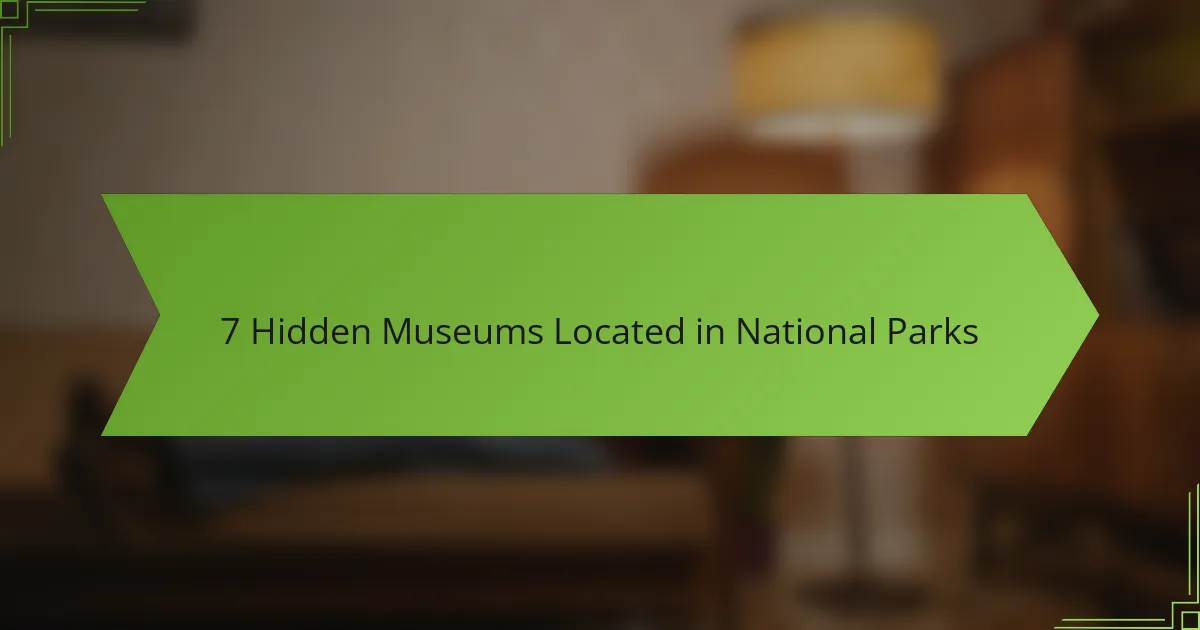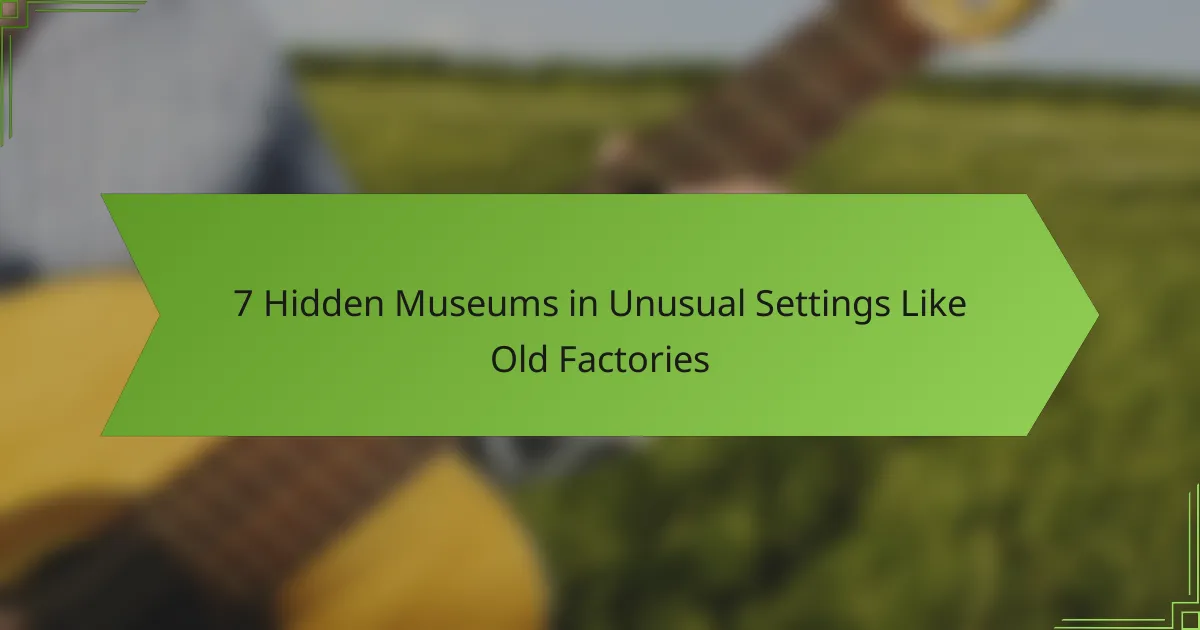Discovering hidden museums in small towns can lead to unique experiences that celebrate local culture and quirky collections. These charming spots often feature unusual themes and artifacts, providing travelers with engaging activities and insights into the community’s heritage. Planning your visit with attention to details like opening hours and nearby attractions will enhance your exploration of these fascinating treasures.

What Are the Best Hidden Museums in Small Towns?
The best hidden museums in small towns offer unique experiences that showcase quirky collections and local culture. These museums often highlight unusual themes and artifacts, making them intriguing stops for travelers seeking something different.
The Museum of Bad Art (Massachusetts)
The Museum of Bad Art, located in Dedham, Massachusetts, is dedicated to the collection and display of art that is deemed “bad.” This unconventional museum celebrates the creativity of artists whose works may not meet traditional standards of beauty, offering a humorous perspective on art appreciation.
Visitors can explore a variety of pieces that range from awkward portraits to bizarre landscapes. The museum encourages guests to embrace the imperfections in art, making it a light-hearted experience that challenges conventional notions of artistic merit.
International Banana Museum (California)
The International Banana Museum in Mecca, California, is a whimsical tribute to all things banana. With over 20,000 banana-related items, this museum showcases everything from banana-themed art to quirky memorabilia, making it a fun stop for families and banana enthusiasts alike.
While visiting, guests can enjoy banana-flavored treats and learn about the fruit’s history and cultural significance. The museum’s vibrant atmosphere and playful exhibits make it a delightful experience for those looking to explore something off the beaten path.
The World’s Largest Chest of Drawers (North Carolina)
Located in High Point, North Carolina, the World’s Largest Chest of Drawers is an iconic roadside attraction that pays homage to the city’s furniture industry. This massive structure, designed to look like a chest of drawers, stands 36 feet tall and is a testament to local craftsmanship.
While it is not a traditional museum, the chest serves as a unique landmark that draws visitors interested in the history of furniture manufacturing. It’s a great photo opportunity and a conversation starter about the region’s heritage.
Leila’s Hair Museum (Missouri)
Leila’s Hair Museum in Independence, Missouri, is a fascinating collection dedicated to hair art and history. This museum features over 600 pieces of hair art, including intricate wreaths and jewelry made from human hair, showcasing a unique aspect of Victorian culture.
Visitors can learn about the significance of hair in different cultures and the techniques used to create these delicate pieces. The museum offers a rare glimpse into a forgotten art form, making it a must-see for those interested in the unusual.
The Mini Time Machine Museum of Miniatures (Arizona)
The Mini Time Machine Museum of Miniatures in Tucson, Arizona, is a charming museum that features an extensive collection of miniature houses and scenes. This museum invites visitors to step into a world of tiny craftsmanship, showcasing intricate details and imaginative designs.
Guests can explore various themed exhibits, including historical replicas and whimsical fantasy settings. The museum also offers hands-on activities for children, making it an engaging experience for families.
Jell-O Gallery (New York)
The Jell-O Gallery in Le Roy, New York, is a quirky museum dedicated to the history and cultural impact of Jell-O. This small museum features exhibits on the dessert’s origins, its popularity in American households, and even a collection of Jell-O-related memorabilia.
Visitors can enjoy interactive displays and learn about the various flavors and recipes that have made Jell-O a staple in American cuisine. The gallery provides a fun and nostalgic experience for those who appreciate this wobbly treat.
American Museum of Magic (Michigan)
The American Museum of Magic in Marshall, Michigan, is a treasure trove for magic enthusiasts. This museum houses a vast collection of magic memorabilia, including props, posters, and personal artifacts from famous magicians throughout history.
Visitors can explore exhibits that detail the evolution of magic and illusion, as well as enjoy live performances and demonstrations. The museum offers a captivating experience for anyone interested in the art of magic and its impact on entertainment.

What Unique Experiences Do These Museums Offer?
These hidden museums in small towns provide unique experiences through engaging activities, unusual collections, and insights into local culture. Visitors can expect hands-on exhibits, one-of-a-kind artifacts, and a deeper understanding of the community’s heritage.
Interactive exhibits
Interactive exhibits allow visitors to engage directly with the displays, enhancing the learning experience. Many small-town museums feature hands-on activities, such as crafting, simulations, or guided tours that encourage participation. For example, a local history museum might offer a replica of a historical site where visitors can role-play significant events.
When visiting, look for museums that promote interaction through technology, such as augmented reality apps or touch-screen displays. These features can make the experience more immersive and memorable.
Quirky collections
Quirky collections often showcase unusual or unexpected items that tell a story about the town’s history or culture. For instance, a small-town museum might house a collection of vintage toys, local art, or even peculiar artifacts like a giant rubber band ball. These collections provide a unique glimpse into the community’s character.
To fully appreciate these collections, take time to read the accompanying descriptions and engage with the curators, who often have fascinating anecdotes about the items. This interaction can enhance your understanding and enjoyment of the exhibits.
Local cultural insights
Local cultural insights are a hallmark of small-town museums, offering visitors a chance to learn about the traditions, customs, and history of the area. Many museums feature exhibits dedicated to local folklore, crafts, and significant historical events that shaped the community. This context can enrich your visit and provide a deeper appreciation for the region.
Consider participating in guided tours or workshops that focus on local culture, such as cooking classes featuring regional cuisine or craft sessions highlighting traditional techniques. These experiences can create lasting memories and a stronger connection to the community.

How to Plan a Visit to These Museums?
Planning a visit to hidden museums in small towns requires attention to details like opening hours, ticket availability, and nearby attractions. By organizing these aspects ahead of time, you can ensure a smooth and enjoyable experience.
Check opening hours
Before visiting, verify the museum’s opening hours as they can vary significantly, especially in smaller towns. Many hidden museums may only operate on specific days or have limited hours, often ranging from a few hours in the afternoon to full days on weekends.
Consider calling ahead or checking the museum’s website for the most accurate information. Some museums may also have seasonal hours, so be mindful of the time of year when planning your visit.
Book tickets in advance
Booking tickets in advance is highly recommended, especially for popular hidden museums that may have limited capacity. Many small-town museums offer online ticket sales, allowing you to secure your spot and avoid potential disappointment.
Check if there are any discounts for groups or special events, as some museums may offer reduced rates for families or local residents. Always review the cancellation policy before purchasing to ensure flexibility in case your plans change.
Explore nearby attractions
Enhance your museum visit by exploring nearby attractions. Many small towns have charming shops, local eateries, or natural landmarks that can complement your museum experience. Researching these options can help you create a full day of activities.
Consider creating a small itinerary that includes the museum and at least one or two nearby sites. This approach not only maximizes your visit but also supports local businesses, enriching your overall experience in the town.

What Are the Benefits of Visiting Small Town Museums?
Visiting small town museums offers unique benefits, including supporting local economies and discovering lesser-known cultural treasures. These museums often provide a more intimate and personalized experience compared to larger institutions.
Support local economies
Small town museums play a vital role in boosting local economies by attracting visitors who spend money on admission, souvenirs, and nearby businesses such as restaurants and hotels. This influx of tourism can help sustain jobs and promote community development.
For example, a small museum might charge a modest admission fee of around $5 to $10, which can significantly contribute to the town’s revenue when combined with the spending of visitors. Supporting these institutions helps ensure that local culture and history are preserved.
Discover hidden gems
Small town museums often house unique collections that reflect the local heritage, art, and history, which may not be found in larger, more mainstream museums. These hidden gems can include quirky exhibits, local artists’ works, or artifacts that tell the story of the town’s past.
Exploring these museums can lead to unexpected discoveries, such as a local inventor’s creations or historical documents that reveal fascinating aspects of the community’s development. Engaging with these treasures fosters a deeper appreciation for the area.
Experience personalized tours
Many small town museums offer personalized tours led by knowledgeable staff or volunteers who are passionate about the exhibits. This intimate setting allows for more in-depth discussions and a chance to ask questions, enhancing the overall experience.
Visitors can often arrange for private tours or special events, which can include hands-on activities or themed experiences tailored to specific interests. This level of engagement is typically less common in larger museums, making small town museums a unique option for those seeking a more personal touch.



